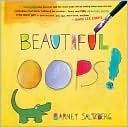Just as I like to work on summarizing throughout the year, I also like to work on comparing texts. Kids naturally enjoy finding connections between texts. If I model this early in the year, we can make strong connections all year long.
I decided to start with two quick pop-up books. The first reason for my choice was a practical one--I wanted really short texts that we could read in five minutes or less. But the second reason was a little deeper. I wanted to show students how even very short texts can communicate a theme in words and pictures.
Book 1: Beautiful Oops
This was an impulse purchase a few weeks ago...and it has now become a classroom favorite! As we read it, we talked about several details:
-The author's use of intentional mistakes
-The playful illustrations and bright colors
-The theme that is expressed
-How the text and pictures support the theme
Book 2: Big Frog Can't Fit In
Of course, my students love the books of Mo Willems, so this has already been passed around the classroom on free-reading Fridays. As we read this, we talked about:
-The problem and solution expressed in the book
-The use of pictures and pop-up elements
-The theme that is expressed
-How the text and pictures support the theme
After we read the books, we completed a chart to compare them, looking at the themes, the illustrations, and the text. One student added a new detail: "Both books show a problem that has to be solved!" When we used the chart to write a paragraph, I modeled starting with the heart of the comparison--why these books are being compared.
Beautiful Oops and Big Frog Can't Fit both express deep ideas through playful words and pictures.
Using my new Elmo wireless tablet (okay, it is really awesome to be able to write on the board from across the room!), we developed the rest of the paragraph by explaining how both books are similar and different. I made a big deal out of the phrase "on the other hand", talking about how sophisticated and grown-up it sounds. :)
After we did this together, students worked in clock buddy pairs to compare the books Molly's Pilgrim and Weslandia. At this point in the year, I give them a chart with criteria to consider. For these books, the criteria included the themes, how the characters are bullied, how the conflicts are resolved, and so forth. When students went to write their paragraphs, they chose the details from the chart that they wanted to develop. As a result, every pair's paragraph had a different focus. But most were solid and interesting, not bad for early in the fourth grade year! (Ten groups did experiment with "on the other hand", showing me that making a big deal out of the phrase must have made an impact.)
Pop-up books often don't have much of a place in intermediate classrooms...but these books are so engaging that they can really be useful tools.



No comments:
Post a Comment